 Jack London Bookstore
Jack London Bookstore

The Amateur Navigator
By Jack London
Author of "The Call of the Wild," "Martin Eden,""Sea Wolf," etc.
 HERE
are captains and captains, and some mighty fine captains, I know; but the run
of the captains on the Snark has been remarkably otherwise. My
experience with them has been that it is harder to take care of one captain on
a small boat than of two small babies. Of course, this is no more than is to be
expected. The good men have positions, and are not likely to forsake their
one-thousand to fifteen-thousand-ton billets for the Snark with her ten
tons net. The Snark has had to cull her navigators from the beach, and
the navigator on the beach is usually a congenital inefficient - the sort of
man who beats about for a fortnight trying vainly to find an ocean isle and who
returns with his schooner to report the island sunk with all on board, the sort
of man whose temper or thirst for strong waters works him out of billets faster
than he can work into them.
HERE
are captains and captains, and some mighty fine captains, I know; but the run
of the captains on the Snark has been remarkably otherwise. My
experience with them has been that it is harder to take care of one captain on
a small boat than of two small babies. Of course, this is no more than is to be
expected. The good men have positions, and are not likely to forsake their
one-thousand to fifteen-thousand-ton billets for the Snark with her ten
tons net. The Snark has had to cull her navigators from the beach, and
the navigator on the beach is usually a congenital inefficient - the sort of
man who beats about for a fortnight trying vainly to find an ocean isle and who
returns with his schooner to report the island sunk with all on board, the sort
of man whose temper or thirst for strong waters works him out of billets faster
than he can work into them.
The Snark has had three captains, and by
the grace of God she shall have no more. The first captain was so senile as to
be unable to give a measurement for a boom-jaw to a carpenter. So utterly
agedly helpless was he, that he was unable to order a sailor to throw a few
buckets of salt water on the Snark's deck. For twelve days, at anchor,
under an overhead tropic sun, the deck lay dry. It was a new deck. It cost me
$135 to recalk it. The second captain was angry. He was born angry. "Papa
is always angry," was the description given him by his half-breed son.
This captain required eighteen hours to bring the Snark twelve miles in
a spanking breeze. Also he required a quart of whiskey for the same twelve
miles. The thrid captain was so crooked that he could n't hide behind a
corkscrew. The truth was not in him, common honesty was not in him, and he was
as far away from fair play and square-dealing as he was from his proper course
when he nearly wrecked the Snark on the Ringgold Isles.
It was at Suva, in the Fijis, that I discharged
my third and last captain and took up once more the role of amateur navigator.
I had essayed it once before, under my first captain, who, out of San
Francisco, jumped the Snark so amazingly over the chart that I really
had to find out what was doing. It was fairly easy to find out, for we had a
run of 2100 miles before us. I knew nothing of navigation; but, after several
hours of reading up and half an hour's practice with the sextant, I was able to
find the Snark's latitude by meridian observation and her longitude by
the simple method known as "equal altitudes." This is not a correct
method. It is not even a safe method, but my captain was attempting to navigate
by it, and he was the only one on board who should have been able to tell me
that it was a method to be eschewed. I brought the Snark to Hawaii, but
the conditions favored me. The sun was in northern declination and nearly
overhead. The legitimate "chronometer-sight" method of ascertaining
the longitude I had not heard of - yes, I had heard of it. My first captain
mentioned it vaguely, but after one or two attempts at it he mentioned it no
more.
I had time in the Fijis to compare my chronometer
with two other chronometers. Two weeks previous, at Pago Pago, in Samoa, I had
asked my captain to compare our chronometer with the chronometers on the
American cruiser, the Annapolis.
 This he told me he had done - of course he had done nothing of the sort; and
he told me that the difference he had ascertained was only a small fraction of
a second. He told it to me with finely simulated joy and with words of praise
for my splendid time-keeper. I repeat it now, with words of praise for his
splendid and unblushing unveracity. For behold, fourteen days later, in Suva,
I compared the chronometer with the one on the Atua, an Australian
steamer, and found that mine was thirty-one seconds fast. Now thirty-one
seconds of time, converted into arc, equals seven and one-quarter miles. That
is to say, if I were sailing west, in the night-time, and my position,
according to my dead reckoning from my afternoon chronometer sight, was shown
to be seven miles off the land, why, at that very moment I would be crashing on
the reef. Next I compared my chronometer with Captain Wooley's. Captain Wooley,
the harbormaster, gives the time to Suva, firing a gun-signal at twelve, noon,
three times a week. According to his chronometer mine was fifty-nine seconds
fast, which is to say, that, sailing west, I should be crashing on the reef
when I thought I was fifteen miles off from it.
This he told me he had done - of course he had done nothing of the sort; and
he told me that the difference he had ascertained was only a small fraction of
a second. He told it to me with finely simulated joy and with words of praise
for my splendid time-keeper. I repeat it now, with words of praise for his
splendid and unblushing unveracity. For behold, fourteen days later, in Suva,
I compared the chronometer with the one on the Atua, an Australian
steamer, and found that mine was thirty-one seconds fast. Now thirty-one
seconds of time, converted into arc, equals seven and one-quarter miles. That
is to say, if I were sailing west, in the night-time, and my position,
according to my dead reckoning from my afternoon chronometer sight, was shown
to be seven miles off the land, why, at that very moment I would be crashing on
the reef. Next I compared my chronometer with Captain Wooley's. Captain Wooley,
the harbormaster, gives the time to Suva, firing a gun-signal at twelve, noon,
three times a week. According to his chronometer mine was fifty-nine seconds
fast, which is to say, that, sailing west, I should be crashing on the reef
when I thought I was fifteen miles off from it.
I compromised by subtracting thirty-one seconds
from the total of my chronometer's losing error, and sailed away for Tanna, in
the New Hebrides, resolved, when nosing around the land on dark nights, to bear
in mind the other seven miles I might be out according to Captain Wooley's
instrument. Tanna lay some 600 miles west-southwest from the Fijis, and it was
my belief that while covering that distance I could quite easily knock into my
head sufficient navigation to get me there. Well, I got there, but listen first
to my troubles. Navigation is easy, I shall always contend that; but
when a man is taking three gasoline engines and a wife around the world and is
writing hard every day to keep the engines supplied with gasoline and the wife
with pearls and volcanoes, he has n't much time left in which to study
navigation. Also, it is bound to be easier to study said science ashore, where
latitude and longitude are unchanging, in a house whose position never alters,
than it is to study navigation on a boat that is rushing along day and night
toward land that one is trying to find, and which he is liable to find
disastrously at a moment when he least expects it.
To begin with, there are the compasses and the
setting of the courses. We sailed from Suva on Saturday afternoon, June 6,
1908, and it took us till after dark to run the narrow, reef-ridden passage
between the islands of Viti Levu and Mbengha. The open ocean lay before me.
There was nothing in the way, with the exception Vatu Leile, a miserable little
island that persisted in poking up through the sea some twenty miles to the
west-southwest - just where I wanted to go. Of course, it seemed quite simple
to avoid it by steering a course that would pass it eight or ten miles to the
north. It was a black night, and we were running before the wind. The man at
the wheel must be told what direction to steer in order to miss Vatu Leile.
But what direction? I turned me to the navigation books.
"True Course" I lighted upon. The very thing! What I wanted was the
true course. I read eagerly on:
"The True Course is the angle made with the meridian by a straight line on the chart drawn to connect the ship's position with the place bound to."
Just what I wanted. The Snark's position
was at the western entrance of the passage between Viti Levu and Mbengha. The
immediate place she was bound to was a place on the chart ten miles north of
Vatu Leile. I pricked that place off on the chart with my dividers, and with my
parallel rulers found that west-by-south was the true course. I had but to give
it to the man at the wheel and the Snark would win her way to the safety
of the open sea.
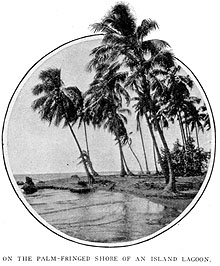 But alas and alack and lucky for me, I read on. I
discovered that the compass, that trusty, everlasting friend of the mariner,
was not given to pointing north. It varied. Sometimes it pointed east of north,
sometimes west of north, and on occasion it even turned tail on north and
pointed south. The variation at the particular spot on the globe occupied by
the Snark was nine degrees forty minutes easterly. Well, that had to be
taken into account before I gave the steering course to the man at the wheel. I
read:
But alas and alack and lucky for me, I read on. I
discovered that the compass, that trusty, everlasting friend of the mariner,
was not given to pointing north. It varied. Sometimes it pointed east of north,
sometimes west of north, and on occasion it even turned tail on north and
pointed south. The variation at the particular spot on the globe occupied by
the Snark was nine degrees forty minutes easterly. Well, that had to be
taken into account before I gave the steering course to the man at the wheel. I
read:
"The Correct Magnetic Course is derived from the True Course by applying to it the variation."
Therefore, I reasoned, if the compass points nine
degrees forty minutes eastward of north, and I wanted to sail due north, I
should have to steer nine degrees forty minutes westward of the north indicated
by the compass, and which was not north at all. So I added nine degrees forty
minutes to the left of my west-by-south course, thus getting my correct
Magnetic Course, and was ready once more to run to open sea.
Again, alas and alack! The Correct Magnetic
Course was not the Compass Course. There was another sly little devil lying in
wait to trip my up and land me smashing on the reefs of Vatu Leile. This little
devil went by the name of Deviation. I read:
"The Compass Course is the course to steer, and is derived from the Correct Magnetic Course by applying to it the Deviation."
Now Deviation is the variation in the needle
caused by the distribution of iron on board ship. This purely local variation I
derived from the deviation card of my standard compass and then applied to the
Correct Magnetic Course. The result was the Compass Course. And yet, not yet.
My standard compass was amidships on the companionway. My steering compass was
aft, in the cock-pit, near the wheel. When the steering compass pointed
west-by-south-three-quarters-south (the steering course), the standard compass
pointed west-one-half-north, which was certainly not the steering course. I
kept the Snark up till she was heading west-by-south-three-quarters
south on the standard compass, which gave, on the steering compass,
southwest-by-west.
 The foregoing operations constitute the simple
little matter of setting a course. And the worst of it is that one must perform
every step correctly or else he will hear, "Breakers ahead!" some
pleasant night, receive a nice sea-bath, and be given the delightful diversion
of fighting the way to the shore through a horde of man-eating sharks.
The foregoing operations constitute the simple
little matter of setting a course. And the worst of it is that one must perform
every step correctly or else he will hear, "Breakers ahead!" some
pleasant night, receive a nice sea-bath, and be given the delightful diversion
of fighting the way to the shore through a horde of man-eating sharks.
Just as the compass is tricky and strives to fool
the mariner by pointing in all directions except north, so does that guide-post
of the sky, the sun, persist in not being where it ought to be at a given time.
This carelessness of the sun is the cause of more trouble - at least, it caused
trouble for me. To find out where one is on the earth's surface, he must know,
at precisely the same time, where the sun is in the heavens. That is to say,
the sun, which is the timekeeper for men, does n't run on time. When I
discovered this, I fell into deep gloom and all the Cosmos was filled with
doubt. Immutable laws, such as gravitation and the conservation of energy,
became wobbly, and I was prepared to witness their violation at any moment to
remain unastonished. For see, if the compass lied and the sun did not keep its
engagement, why should not objects lose their mutual attractions, and why
should not a few bushel-baskets of force be annihilated? Even perpetual motion
became possible, and I was in a frame of mind prone to purchase Keeley-Motor
stock from the first enterprising agent that landed on the Snark's deck.
And when I discovered that the earth really rotated on its axis 366 times a
year, while there were only 365 sunrises and sunsets, I was ready to doubt my
own identity.

This is the way of the sun. It is so irregular
that it is impossible for man to devise a clock that will keep the sun's time.
The sun accelerates and retards as no clock could be made to accelerate and
retard. The sun is sometimes ahead of its schedule; at other times it is
lagging behind; and at still other times it is breaking the speed limit in
order to overtake itself, or, rather, to catch up with where it ought to be in
the sky.

In this last case it does not slow down quick enough, and, as a result, goes dashing ahead of where it ought to be. In fact, only four days in a year do the sun and the place where the sun ought to be happen to coincide. The remaining 361 days the sun is pothering around all over the shop. Man, being more perfect than the sun, makes a clock that keeps regular time. Also, he calculates how far the sun is ahead of its schedule or behind. The difference between the sun's position and the position where the sun ought to be, if it were a decent, self-respecting sun, man calls the Equation of Time.

Thus, the navigator, endeavoring to find his ship's position on the sea, looks
in his chronometer to see where precisely the sun ought to be according to the
Greenwich custodian of the sun. Then to that location he applies the Equation
of Time and finds out where the sun ought to be and is n't. This latter
location, along with several other locations, enables him to find out what the
man from Kansas demanded to know some years ago.
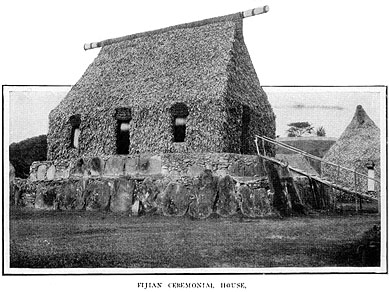 The Snark sailed from Fiji on Saturday, June 6, and the next day,
Sunday, on the wide ocean, out of sight of land, I proceeded to endeavor to
find out my position by a chronometer sight for longitude and by a meridian
observation for latitude. The chronometer sight was taken in the morning, when
the sun was some twenty-one degrees above the horizon. I looked in the Nautical
Almanac and found that on that very day, June 7, the sun was behind time 1
minute and 26 seconds, and that it was catching up at the rate of 14.67 seconds
per hour. The chronometer said that at the precise moment of taking the sun's
altitude it was twenty-five minutes after eight o'clock at Greenwich. From this
data it would seem a schoolboy's task to correct the Equation of Time.
Unfortunately, I was not a schoolboy. Obviously, at the middle of the day, at
Greenwich, the sun was 1 minute and 26 seconds behind time. Equally obviously,
if it were eleven o'clock in the morning the sun would be 1 minute and 26
seconds behind time plus 14.67 seconds. If it were ten o'clock in the morning
twice 14.67 seconds would have to be added. And if were 8:25 in the morning,
then 3 ½ times 14.67 seconds would have to be added. Quite
clearly, then, if, instead of being 8:25 A. M., it were 8:25 P. M., then 8
½ times 14.67 seconds would have to be, not added, but
subtracted; for, if, at noon, the sun were 1 minute and 26 seconds
behind time, and if it were catching up with where it ought to be at the rate
of 14.67 seconds per hour, then, at 8:25 P. M. it should be much nearer where
it ought to be than had it been at noon.
The Snark sailed from Fiji on Saturday, June 6, and the next day,
Sunday, on the wide ocean, out of sight of land, I proceeded to endeavor to
find out my position by a chronometer sight for longitude and by a meridian
observation for latitude. The chronometer sight was taken in the morning, when
the sun was some twenty-one degrees above the horizon. I looked in the Nautical
Almanac and found that on that very day, June 7, the sun was behind time 1
minute and 26 seconds, and that it was catching up at the rate of 14.67 seconds
per hour. The chronometer said that at the precise moment of taking the sun's
altitude it was twenty-five minutes after eight o'clock at Greenwich. From this
data it would seem a schoolboy's task to correct the Equation of Time.
Unfortunately, I was not a schoolboy. Obviously, at the middle of the day, at
Greenwich, the sun was 1 minute and 26 seconds behind time. Equally obviously,
if it were eleven o'clock in the morning the sun would be 1 minute and 26
seconds behind time plus 14.67 seconds. If it were ten o'clock in the morning
twice 14.67 seconds would have to be added. And if were 8:25 in the morning,
then 3 ½ times 14.67 seconds would have to be added. Quite
clearly, then, if, instead of being 8:25 A. M., it were 8:25 P. M., then 8
½ times 14.67 seconds would have to be, not added, but
subtracted; for, if, at noon, the sun were 1 minute and 26 seconds
behind time, and if it were catching up with where it ought to be at the rate
of 14.67 seconds per hour, then, at 8:25 P. M. it should be much nearer where
it ought to be than had it been at noon.

 So far so good. But was that 8:25 of the
chronometer A. M. or P. M.? I looked at the Snark's clock. It marked
8 :9, and it was certainly A. M., for I had just finished breakfast. Therefore,
if it was eight in the morning on board the Snark, the eight o'clock of
the chronometer (which was the time of the day at Greenwich), must be a
different eight o'clock from the Snark's eight o'clock.
But what eight o'clock was it? It cant be the eight o'clock of
this morning, I reasoned; therefore it must be either eight o'clock this
evening or eight o'clock last night.
So far so good. But was that 8:25 of the
chronometer A. M. or P. M.? I looked at the Snark's clock. It marked
8 :9, and it was certainly A. M., for I had just finished breakfast. Therefore,
if it was eight in the morning on board the Snark, the eight o'clock of
the chronometer (which was the time of the day at Greenwich), must be a
different eight o'clock from the Snark's eight o'clock.
But what eight o'clock was it? It cant be the eight o'clock of
this morning, I reasoned; therefore it must be either eight o'clock this
evening or eight o'clock last night.
It was at this juncture that I fell into the
bottomless pit of intellectual chaos. We are in east longitude, I reasoned,
therefore we are ahead of Greenwich. If we are behind Greenwich, then today is
yesterday; if we are ahead of Greenwich then yesterday is today - but if
yesterday is today, what under the sun is today! - tomorrow? Absurd! Yet it
must be correct. When I took the sun this morning at 8:25, the sun's custodians
at Greenwich were just arising from dinner last night.
"Then correct the Equation of Time for
yesterday," says my logical mind.
"But today is today," my literal mind
insists. "I must correct the sun for today and not for
yesterday."
"Yet today is yesterday," urges my
logical mind.
"That 's all very well," my literal
mind continues. "If I were in Greenwich I might be in yesterday. Strange
things happen in Greenwich. But I know as sure as I am living that I am here,
now, in today, June 7, and that I took the sun here, now, today, June 7.
Therefore I must correct the sun here, now, today, June 7."

"Bosh!" snaps my logical mind.
"Lecky says - "
"Never mind what Lecky says,"
interrupts my literal mind. "Let me tell you what the Nautical Almanac
says. The Nautical Almanac says that today, June 7, the sun was 1 minute and 26
seconds behind time and catching up at the rate of 14.67 seconds per hour.
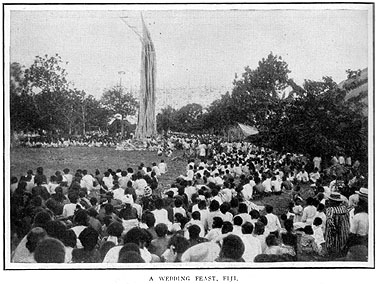 It says that yesterday, June 6, the sun was 1 minute and 36 seconds behind time
and catching up at the rate of 15.66 seconds per hour. You see, it is
preposterous to think of correcting today's sun by yesterday's
time-table."
It says that yesterday, June 6, the sun was 1 minute and 36 seconds behind time
and catching up at the rate of 15.66 seconds per hour. You see, it is
preposterous to think of correcting today's sun by yesterday's
time-table."
"Fool!"
"Idiot!"
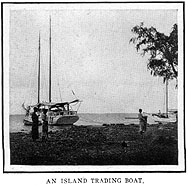 Back and forth they wrangle until my head is
whiling around and I am ready to believe that I am in the day after the last
week before next.
Back and forth they wrangle until my head is
whiling around and I am ready to believe that I am in the day after the last
week before next.
I remember a parting caution of the Suva
harbormaster: "In East Longitude take from the Nautical Almanac the
elements for the preceding day."
Then a new thought came to me. I corrected the
Equation of Time for Sunday and for Saturday, making two separate operations of
it, and lo, when the results were compared there was a difference only of
four-tenths of a second. I was a changed man. I had found my way out of the
crypt. The Snark was scarcely big enough to hold me and my
exuberance. Four-tenths of a second would make a difference of only one-tenth
of a mile - a cable-length!
All went merrily for ten minutes, when I chanced
upon the following rhyme for navigators:
"Greenwich time least,
Longitude East;
Greenwich time best,
Greenwich West."
Heavens! The Snark's time was not as good
as Greenwich time. When it was 8:25 at Greenwich, on board the Snark it
was only 8 :9. "Greenwich time best, longitude west." There I was. In
west longitude beyond a doubt.
"Silly!" cries my literal mind.
"You are 8 :9 A. M. and Greenwich is 8:25 P. M."
"Very well," answers my logical mind.
"To be correct, 8:25 P. M. is really twenty hours and twenty-five minutes,
and that is certainly better than eight hours and nine minutes. No, there is no
discussion; you are in West Longitude."
Then my literal mind triumphs.
"We sailed from Suva, in the Fijis, did n't
we?" it demands, and logical mind agrees. "And Suva is in East
Longitude?" Again logical mind agrees. "And we sailed west, (which
would take us deeper into East Longitude), did n't we? Therefore, you can't
escape it, we are in East Longitude."
"Greenwich time best, Longitude West,"
chants my logical mind; "and you must grant that twenty hours and
twenty-five minutes is better than eight hours and nine minutes."
"All right," I break in upon the
squabble; "we 'll work up the sight and then we 'll see."
And work it up I did, only to find that my
longitude was 184 degrees west.
"I told you so," snorts my logical
mind.
I am dumbfounded. So is my literal mind, for
several minutes.
"But there is no 184 degrees west longitude,
nor east longitude, nor any other longitude. The large largest meridian is 180
degrees as you ought to know very well."
Having got this far, literal mind collapses from
the brain strain, logical mind is dumb flabbergasted; and as for me, I get a
bleak and wintry look in my eyes and go around wondering whether I am sailing
toward the China Coast or the Gulf of Darien.
Then a thin small voice, which I do not
recognize, coming from nowhere in particular in my consciousness says:
"The total number of degrees is 360.
Subtract the 184 degrees west longitude from 360 degrees and you will get 176
degrees east longitude."
"That is sheer speculation," objects
literal mind; and logical mind remonstrates, "There is no rule for
it."
"Darn the rules!" I exclaim. "Aint
I here?"
"The thing is self evident," I
continue. "One hundred and eighty-four degrees west longitude means a
lapping over into east longitude of four degrees. Besides, I have been in east
longitude all the time. I sailed from Fiji and Fiji is in east longitude. Now I
shall chart my position and prove it by dead reckoning."
But other troubles and doubts awaited me. Here is
a sample of one. In south latitude, when the sun is in northern declination,
chronometer sights are taken early in the morning. I took mine at eight
o'clock. Now, one of the necessary elements in working up such a sight is
latitude. But one gets latitude at twelve o'clock, noon, by a meridian
observation. It is clear that in order to work up my eight o'clock chronometer
sight I must have my eight o'clock latitude. Of course, if the Snark
were sailing due west at six knots per hour for the intervening four hours her
latitude would not change. But if she were sailing due south her latitude would
change to the tune of twenty-four miles. In which case a simple addition or
subtraction would convert the twelve o'clock latitude into eight o'clock
latitude. But suppose the Snark were sailing south-west. Then the
traverse tables must be consulted.
This is the illustration. At eight A. M. I took
my chronometer sight. At the same moment the distance recorded on the log was
noted. At twelve M., when the sight for latitude was taken, I again noted the
log, which showed me that since eight o'clock the Snark had run
twenty-four miles. Her true course had been west ¾ south. I
entered Table I, in the distance column, on the page for ¾
point courses, and stopped at 24, the number of miles run. Opposite, in the
next two columns, I found that the Snark had made 3.5 miles of southing
or latitude, and that she had made 23.7 miles of westing. To find my eight
o'clock latitude was easy. I had but to subtract 3.5 miles from my noon
latitude. All the elements being present, I worked up my longitude. But this
was my eight o'clock longitude. Since then, and up till noon, I had made 23.7
miles of westing. What was my noon longitude? I followed the rule, turning to
Traverse Table II. Entering the table according to rule, and going through
every detail according to rule, I found the difference of longitude for the
four hours to be 25 miles. I was aghast.
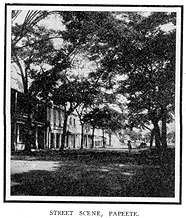 I entered the table again, according to rule; I entered the table half a dozen
times, according to rule, and every time found that my difference of longitude
was 25 miles. I leave it up to you, gentle reader. Suppose you had sailed due
west 24 miles, and not changed your latitude, how could you have changed your
longitude 25 miles? In the name of human reason, how could you cover one mile
more of longitude that the total number of miles you had sailed?
I entered the table again, according to rule; I entered the table half a dozen
times, according to rule, and every time found that my difference of longitude
was 25 miles. I leave it up to you, gentle reader. Suppose you had sailed due
west 24 miles, and not changed your latitude, how could you have changed your
longitude 25 miles? In the name of human reason, how could you cover one mile
more of longitude that the total number of miles you had sailed?
It was a reputable traverse table, being none
other than Bowditch's. The rule was simple (as navigators' rules go); I had
made no error. I spent an hour over it, and at the end still faced the glaring
impossibility of having sailed twenty-four miles, in the course of which I
changed my latitude three and one-half miles and my longitude twenty-five
miles. The worst of it was there was nobody to help me out. Neither Charmian
nor Martin knew as much as I knew about navigation. And all the time the
Snark was rushing madly along toward Tanna, in the New Hebrides.
Something had to be done.
How it came to me I know not - call it an
inspiration if you will; but the thought arose in me: if southing is latitude,
why is n't westing longitude? Why should I have to change westing into
longitude? And then the whole beautiful situation dawned upon me. The meridians
of longitude are sixty miles (nautical) apart at the equator. At the poles they
run together. Thus, if I should travel up the 180 meridian longitude until I
reached the North Pole, and if the astronomer at Greenwich travelled up the 0
degree of meridian of longitude to the North Pole, then, at the North Pole, we
could shake hands with each other, though before we started for the North Pole
we had been some thousands of miles apart. Again: if a degree of longitude was
sixty miles at the equator, and if the same degree, at the point of the Pole,
had no width, then somewhere between the Pole and the equator that degree would
be half a mile wide, and at other places a mile wide, two miles wide, ten miles
wide, thirty miles wide, ay, and sixty miles wide.
All was plain again. The Snark was in 19
degrees south latitude. The world was n't as big around there as at the
equator. Therefore every mile of westing at 19 degrees south was more than a
minute of longitude; for sixty miles were sixty miles, but sixty minutes were
sixty miles only at the equator. George Francis Train broke Jules Verne's
record of around the world. But any man that wants to can break George Francis
Train's record. Such a man would need only to go, in a fast steamer, to the
latitude of Cape Horn, and sail due east all the way around. The world is very
small in that latitude, and there is no land in the way to turn him out of his
course. If his steamer maintained sixteen knots he would circumnavigate the
globe in just about 40 days.
But there are compensations. On Wednesday
evening, June 10, I brought up my noon position by dead reckoning to eight P.
M. Then I projected the Snark's course and saw that she would strike
Futuna, one of the easternmost of the New Hebrides, a volcanic cone two
thousand feet high that rose out of the deep ocean. I altered the course so
that the Snark would pass ten miles to the northward. Then I spoke to
Wada, the cook, who had the wheel every morning from four to six:
"Wada San, tomorrow morning, your watch,
you look sharp on weather-bow you see land."
And then I went to bed. The die was cast. I had
staked my reputation as a navigator. Suppose, just suppose, that at daybreak
there was no land. Then where would my navigation be? And where would we be?
And how would we ever find ourselves? or any land? I caught ghastly visions of
the Snark sailing for months through ocean solitudes and seeking vainly
for land while we consumed our provisions and sat down with haggard faces to
stare cannibalism in the face.
I confess my sleep was not " . . . like a
summer sky that held music of a lark." Rather did "I waken to the
voiceless dark," and listen to the creaking of the bulkheads and the
rippling of the sea alongside as the Snark logged steadily her six knots
an hour. I went over my calculations again and again, striving to find some
mistake until my brain was in such fever that it discovered dozens of mistakes.
Suppose, instead of being sixty miles off Futuna, that my navigation was all
wrong and that I was only six miles off? In which case my course would be
wrong, too, and for all I knew the Snark might be running straight at
Futuna. For all I knew the Snark might strike Futuna the next moment. I
almost sprang from the bunk at that thought; and, though I restrained myself, I
know that I lay for a moment, nervous and tense, waiting for the shock.
My sleep was broken by miserable nightmares.
Earthquake seemed the favorite affliction, though there was one man, with a
bill, who persisted in dunning me throughout the night. Also, he wanted to
fight; and Charmian continually persuaded me to let him alone. Finally,
however, the man with the everlasting dun ventured into a dream from which
Charmian was absent. It was my opportunity, and we went at it, gloriously, all
over the sidewalk and street, until he cried enough. Then I said, "Now how
about that bill?" Having conquered, I was willing to pay. But the man
looked at me and groaned. "It was all a mistake," he said; "the
bill is for the house next door."
That settled him, for he worried my dreams no
more; and it settled me, too, for I woke up chuckling at the episode. It was
three in the morning. I went up on deck. Henry, the Rapa Islander, was
steering. I looked at the log. It recorded forty-two miles. The Snark
had not abated her six-knot gait, and she had not struck Futuna yet. At
half-past five I was again on deck. Wada, at the wheel, had seen no land. I sat
on the cockpit rail, a prey to morbid doubt for a quarter of an hour. Then I
saw land, a small high piece of land, just where it ought to be, rising from
the water on the weather bow. At six o'clock I could clearly make it out to be
the beautiful volcanic cone of Futuna. At eight o'clock, when it was abreast, I
took its distance by the sextant and found it to be be 9.3 miles away. And I
had elected to pass it ten miles away.
Then, to the south, Aneiteum rose out of the sea,
to the north, Aniwa, and dead ahead, Tanna. There was no mistaking Tanna, for
the smoke of its volcano was towering high in the sky. It was forty miles away,
and by afternoon, as we drew close, never ceasing to log our six knots, we saw
that it was a mountainous, hazy land, with no apparent openings in its
coastline. I was looking for Port Resolution, though I was quite prepared to
find that as an anchorage it had been destroyed. Volcanic earthquakes had
lifted its bottom during the last forty years, so that where once the largest
ships rode at anchor there was not, by last reports, scarcely space and depth
sufficient for the Snark. And why should not another convulsion, since
the last report, have closed the harbor completely?
I ran in close to the unbroken coast, fringed
with rocks awash upon which the crashing trade-wind sea burst white and high.
I searched with my glasses for miles, but could see no entrance. I took a
compass bearing of Fununa, another of Aniwa, and laid them off on the chart.
Where the two bearings crossed was bound to be the position of the
Snark. Then, with my parallel rulers, I laid a course from the
Snark's position to Port Resolution. Having corrected this course for
variation and deviation, I went on deck, and lo, the course directed me toward
that unbroken coast-line of bursting seas. To my Rapa Islander's great concern,
I held on till the rocks awash wre an eight of a mile away.
"No harbor this place," he announced,
shaking his head ominously.
But I altered the course and ran along parallel
with the coast. Charmian was at the wheel. Martin was at the engine, ready to
thrown on the propeller. A narrow slit of an opening showed up suddenly.
Through the glasses I could see the seas breaking clear across. Henry, the Rapa
man, looked with troubled eyes; so did Tehei, the Tahaa man.
"No passage there," said Henry.
"We go there we finish quick, sure."
I confess I thought so, too; but I ran on
abreast, watching to see if the line of breakers from one side the entrance did
not overlap the line from the other side. Sure enough, it did. A narrow place
where the sea ran smooth appeared. Charmian put down the wheel and steadied for
the entrance. Martin threw on the engine, while all hands and the cook sprang
to take in sail.
A trader's house showed up in the bight of the
bay. A geyser, on the shore, a hundred yards away, spouted a column of steam.
To port, as we rounded a tiny point, the mission station appeared.
"Three fathoms," cried Wada at the
lead-line.
"Three fathoms," "Two
fathoms," came in quick succession.
Charmian put the wheel down, Martin stopped the
engine, and the Snark rounded to and the anchor rumbled down in three
fathoms. Before we could catch our breaths a swarm of black Tannese were
alongside and aboard - grinning, ape-like creatures, with kinky hair and
troubled eyes, wearing safety-pins and clay pipes in their slitted ears, and as
for the rest wearing nothing behind and less than that before. And I don't mind
telling that that night, when everybody was asleep, I sneaked up on deck,
looked out over the quiet scene, and gloated - yes, gloated - over my
navigation.
From the May, 1910 issue of The Pacific Monthly magazine.
Back to the Jack London Bookstore First Editions.